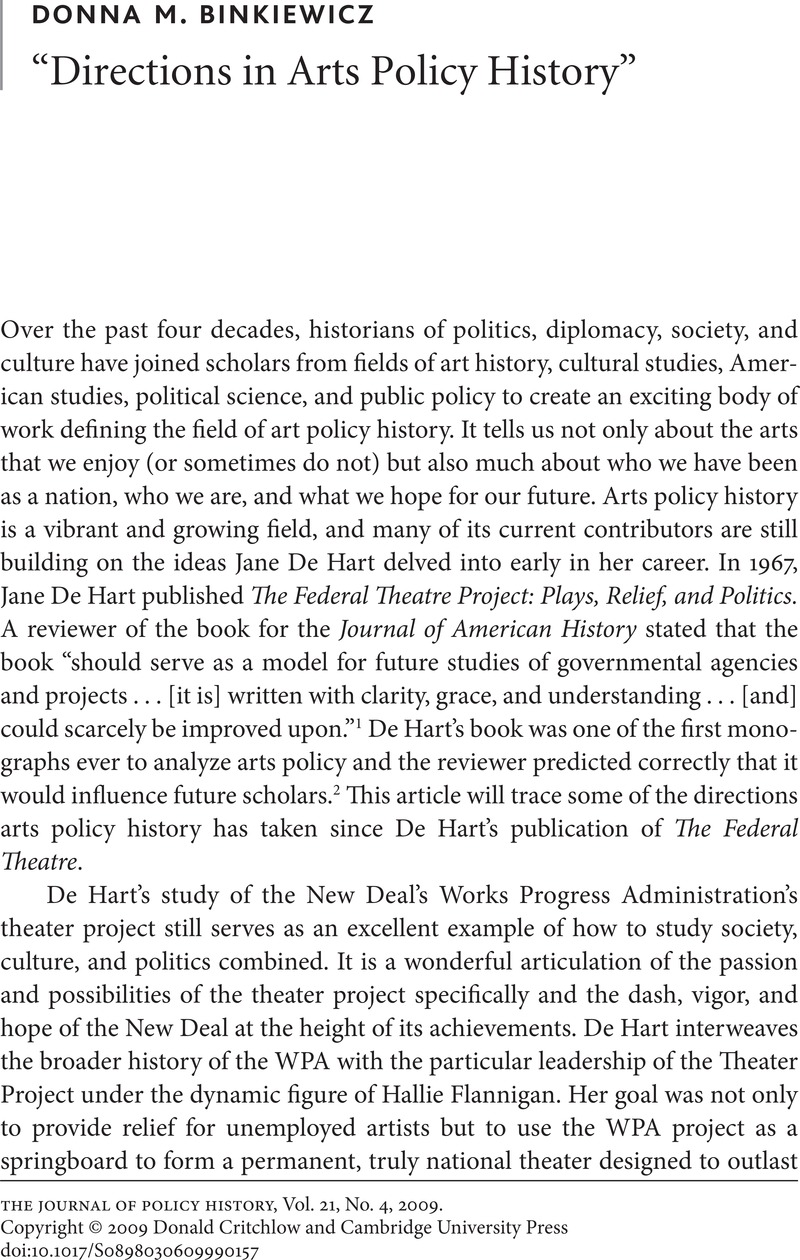Article contents
“Directions in Arts Policy History”
Published online by Cambridge University Press: 01 October 2009
Abstract

- Type
- Forum on The Work of Jane Sherron De Hart
- Information
- Copyright
- Copyright © Donald Critchlow and Cambridge University Press 2009
References
NOTES
1. G. Thomas Tanselle, review of The Federal Theatre Project, in Journal of American History 54, no. 4 (March 1968): 921–22.
2. Indeed, two of us on the panel from which these essays originated owe a debt to Jane De Hart for the directions her work sent us in: Eileen Boris has noted that The Federal Theatre was important for her as she embarked on her career with her first book, Art and Labor: Ruskin, Morris, and the Craftsman Ideal in America (Philadelphia, 1986)Google Scholar, and I followed a similar path with my book Federalizing the Muse: United States Arts Policy and the National Endowment for the Arts, 1965–1980 (Chapel Hill, 2004). I would like to thank Eileen Boris for her efforts in organizing our panel at the 2008 Policy History Conference as well as Linda Kerber for her enthusiasm to publish our forum.
3. Matthews, Jane De Hart, The Federal Theatre Project: Plays, Relief, and Politics (Princeton, 1967), 295Google Scholar.
4. Matthews, Jane De Hart, “Art of the People: The New Deal Quest for Cultural Democracy,” Journal of American History 62, no. 2 (September 1975): 319CrossRefGoogle Scholar.
5. Ibid., 324–25.
6. Mangione, Jerry, The Dream and the Deal: The Federal Writers’ Project, 1935–1943 (Boston, 1972)Google Scholar; McKinzie, Richard, A New Deal for Artists (Princeton, 1973)Google Scholar; Meltzer, Milton, Violins and Shovels: The WPA Arts Projects (New York, 1976)Google Scholar.
7. Ann Marling, Karal, Wall-to-Wall America: A Cultural History of Post Office Murals in the Great Depression (Minneapolis, 1982)Google Scholar; DeNoon, Christopher, Posters of the WPA (Los Angeles, 1987)Google Scholar; Daniel, Peter, Official Images: New Deal Photography (Washington, D.C., 1987)Google Scholar.
8. Fraden, Rena, Blueprint for a Black Federal Theatre (New York: Cambridge University Press, 1996)Google Scholar; Nunn, Tey Marianna, Sin Nombre: Hispana and Hispano Artists of the New Deal Era (Albuquerque, 2001)Google Scholar; and Melosh, Barbara, Engendering Culture: Manhood and Womanhood in New Deal Public Art and Theater (Washington, D.C., 1991)Google Scholar. Another notable work dealing with ethnicity is Schrader’s, Robert FayThe Indian Arts and Crafts Board: An Aspect of New Deal Indian Policy (Albuquerque, 1984)Google Scholar.
9. Harris, Jonathan, Federal Art and National Culture: The Politics of Identity in New Deal America (New York, 1995)Google Scholar.
10. Matthews, Jane De Hart, “Art and Politics in Cold War America,” American Historical Review 81, no. 4 (October 1976): 778Google Scholar.
11. Ibid., 786.
12. Cockcroft, Eva, “Abstract Expressionism, Weapon of the Cold War,” Artforum 12 (June 1974): 39–41Google Scholar.
13. Guilbaut, Serge, How New York Stole the Idea of Modern Art: Abstract Expressionism, Freedom, and the Cold War (Chicago, 1983)Google Scholar.
14. Doss, Erika, Benton, Pollock, and the Politics of Modernism: From Regionalism to Abstract Expressionism (Chicago, 1991)Google Scholar.
15. Krenn, Michael, Fall Out Shelters for the Human Spirit: American Art and the Cold War (Chapel Hill, 2005)Google Scholar; Prevots, Naima, Dance for Export: Cultural Diplomacy and the Cold War (Hanover, N.H., 1998)Google Scholar; and Von Eschen, Penny, Satchmo Blows Up the World: Jazz Ambassadors Play the Cold War (Cambridge, Mass., 2004)Google Scholar.
16. Blake, Casey Nelson, “Atmosphere of Effrontery: Richard Serra, ‘Tilted Arc,’ and the Crisis of Public Art,” in The Power of Culture, ed. Wightman Fox, Richard and Jackson Lears, T. J. (Chicago, 1993), 247–89Google Scholar.
17. Kammen, Michael, “Culture and the State in America,” Journal of American History 83, no. 3 (December 1996): 814CrossRefGoogle Scholar.
18. Binkiewicz, Federalizing the Muse.
19. Blake, Casey N., ed., The Arts of Democracy: Art, Public Culture, and the State (Philadelphia, 2007)Google Scholar.
20. Blake, “Introduction: Public Culture Reconsidered,” in The Arts of Democracy, 6.
- 1
- Cited by




